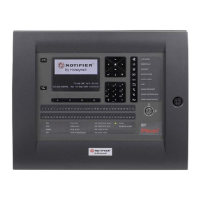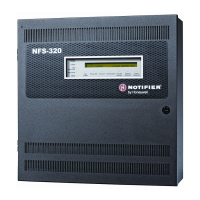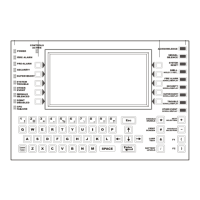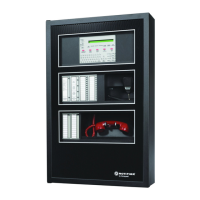Page 66 AFP-2800 - Fire Indicator Panel – Appendix
© N
OTIFIER
I
NERTIA
P
TY
L
TD
, 2001
WWW
.
INERTIA
.
COM
.
AU
5
55
5
5
55
5
.
..
.
.
..
.
3
33
3
3
33
3
.
..
.
.
..
.
2
22
2
2
22
2
W
WW
W
W
WW
W
R
RR
R
R
RR
R
I
II
I
I
II
I
T
TT
T
T
TT
T
I
II
I
I
II
I
N
NN
N
N
NN
N
G
GG
G
G
GG
G
S
SS
S
S
SS
S
C
CC
C
C
CC
C
R
RR
R
R
RR
R
I
II
I
I
II
I
P
PP
P
P
PP
P
T
TT
T
T
TT
T
S
SS
S
S
SS
S
Important notes on writing scripts:
• All scripts must be terminated with a semicolon, ;
• Scripts always belong to the output to which they are controlling.
• A script going true will turn the output on.
• All system input and output points, as seen in section 4.1.4 on Point Formats, can be used in Scripts.
• Scripts can have a maximum bracket ( ) nesting of 10. ie: 10 pairs of brackets.
A delay timer can be added to the end of any script by adding “AND T10” - in this case for a 10 second delay timer.
This means that the script conditions must be true for 10 seconds before the script goes true. You can only have 1
timer per script. Time delays can be up to 180 seconds.
Range functions include all points of the same type within the specified range as a large OR or AND function. This
function is performed as a macro and includes only modules installed at the time of parsing. If modules are added
after this point they will not automatically be included in the range. If you add a module and you and want it
included in range scripts, you must re-parse the script again.
When using a Range Function, if the point you are writing the script for falls within the range, the script will
automatically exclude the point from the script to avoid the output latching on. If you want the output to latch on,
you can manually add the point into the script.
5
55
5
5
55
5
.
..
.
.
..
.
3
33
3
3
33
3
.
..
.
.
..
.
3
33
3
3
33
3
S
SS
S
S
SS
S
C
CC
C
C
CC
C
R
RR
R
R
RR
R
I
II
I
I
II
I
P
PP
P
P
PP
P
T
TT
T
T
TT
T
I
II
I
I
II
I
N
NN
N
N
NN
N
G
GG
G
G
GG
G
E
EE
E
E
EE
E
X
XX
X
X
XX
X
A
AA
A
A
AA
A
M
MM
M
M
MM
M
P
PP
P
P
PP
P
L
LL
L
L
LL
L
E
EE
E
E
EE
E
S
SS
S
S
SS
S
Type Script Description
Or 1.1.z1 or 1.1.z2 or 2.1.i2 or 1.101.i1;
Any of the 3 point in alarm
And 1.1.z1 and 1.1.z2;
Both points required to be in alarm
NOT 1.1.z1 and !1.1.z2;
AZF#1 must be alarm and AZF#2 must NOT be in
alarm.
OR Range (1.1.z1 -> 1.1.z8);
Any AZF on module 1 in alarm
AND Range (1.1.z1 &> 1.1.z8);
ALL AZF’s on module 1 in Alarm.
Fault F1.1.z1;
1.1.z1 is in fault
Isolate I1.1.z1;
1.1.z1 is isolated
Combination examples:
Example Description
(1.1.z1 and 1.1.z2) and !1.1.z3;
AZF 1 and 2 on module 1 and not AZF3 on module 1.
(1.1.i1 -> 1.99.i3) or (1.1.z1 -> 1.99.z8);
And input or any zone on ring 1
CA and T10;
When Common Alarm has been active for 10 seconds.
Caution: When a script is being evaluated and a point in the script is found to be isolated, that point is treated as being inactive (ie.
off or non-alarmed). If the NOT function has been used in the script, this may have unexpected results. For example, a
script such as 1.2.o3 = !1.3.I4; would operate as follows: output 1.2.o3 is ON when input 1.3.I4 is OFF, and the output
1.2.o3 is OFF when input 1.3.I4 is ON. However if input 1.3.I4 is now isolated, output 1.2.o3 will go ON because the script
will treat the isolated point as OFF (inactive). This may or may not be the desired action depending on the application.
5
55
5
5
55
5
.
..
.
.
..
.
3
33
3
3
33
3
.
..
.
.
..
.
4
44
4
4
44
4
M
MM
M
M
MM
M
A
AA
A
A
AA
A
K
KK
K
K
KK
K
I
II
I
I
II
I
N
NN
N
N
NN
N
G
GG
G
G
GG
G
A
AA
A
A
AA
A
N
NN
N
N
NN
N
O
OO
O
O
OO
O
U
UU
U
U
UU
U
T
TT
T
T
TT
T
P
PP
P
P
PP
P
U
UU
U
U
UU
U
T
TT
T
T
TT
T
L
LL
L
L
LL
L
A
AA
A
A
AA
A
T
TT
T
T
TT
T
C
CC
C
C
CC
C
H
HH
H
H
HH
H
.
..
.
.
..
.
The way to latch an output is to include itself in its script, you do need to remember however to include a way to
reset the output. For example, a fire trip relay (L1M3) is required to latch on common alarm and to be reset by
push button 1 on annunciator 1, once all alarms have cleared. A script that will perform this operation is:
L1M3 = CA or (L1M3 and !1.101.i1);
www.PDF-Zoo.com
